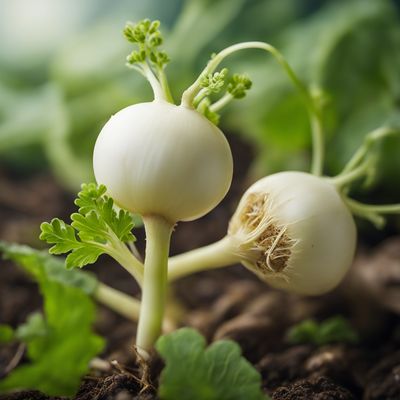
Ingredient
Parsley roots
The Hidden Gem of Parsley
Parsley roots are the edible taproots of the parsley plant, offering a unique combination of earthy, nutty, and slightly sweet flavors. They have a firm texture and resemble parsnips or carrots in appearance. Parsley roots are commonly used in soups, stews, roasted vegetables, and as a garnish for their distinct taste and aroma.
Origins and history
Parsley roots have been cultivated and consumed for centuries, with their origins traced back to the Mediterranean region. They were highly valued in ancient Greece and Rome for their culinary and medicinal properties. Today, parsley roots are widely used in European cuisines, particularly in Eastern European and German dishes.
Nutritional information
Parsley roots are a good source of dietary fiber, vitamins A and C, and minerals such as potassium and calcium. They are also low in calories and fat, making them a nutritious addition to meals.
Allergens
Parsley roots may cause allergic reactions in individuals with known allergies to parsley or other plants in the Apiaceae family, such as carrots, celery, or fennel.
How to select
Choose parsley roots that are firm, smooth, and free from blemishes or soft spots. Look for roots with vibrant green leaves still attached, as this indicates freshness. Avoid roots that are wilted or have signs of mold or decay. Smaller roots tend to be more tender and flavorful.
Storage recommendations
To maintain the freshness of parsley roots, remove the leafy tops and store them separately in the refrigerator. Place the roots in a perforated plastic bag or wrap them in a damp paper towel to prevent them from drying out. Stored properly, parsley roots can last up to two weeks.
How to produce
Parsley roots can be grown in home gardens or containers with well-draining soil and regular watering. Sow the seeds directly in the soil or transplant seedlings, ensuring they receive adequate sunlight. Harvest the roots when they reach the desired size, typically after 12-16 weeks of growth.
Preparation tips
Parsley roots can be used in various culinary preparations. They can be roasted, sautéed, or boiled and mashed as a side dish. They add depth of flavor to soups, stews, and stocks. Parsley roots can also be grated and used in salads or pickled for a tangy twist. The leafy tops can be chopped and used as a garnish or added to salads and sauces for an extra burst of parsley flavor.
Substitutions
Carrots or parsnips can be used as substitutes for parsley roots, although they have slightly different flavors. Carrots offer a sweeter taste, while parsnips have a more pronounced earthy flavor. Adjust the quantity accordingly to achieve a similar taste profile.
Culinary uses
Parsley roots are commonly used in European cuisines, particularly in Eastern European and German dishes. They are often added to soups, stews, and roasted vegetable medleys for their distinct flavor. Parsley roots can also be used as a garnish for added texture and taste.
Availability
Parsley roots are commonly available in Europe, particularly in countries like Germany, Poland, and Hungary. They can also be found in specialty grocery stores or farmers markets in other regions.


